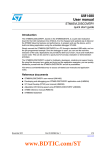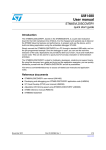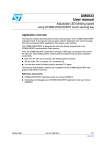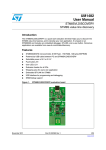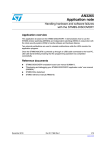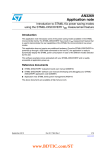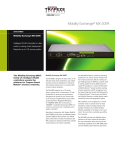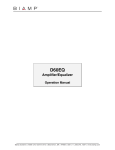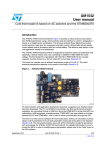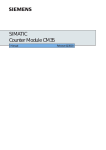Download Adjustable LED blinking speed using STM8SVLDISCOVERY
Transcript
AN3996 Application Note Adjustable LED blinking speed using STM8SVLDISCOVERY Application overview This application note provides a short description of the demonstration firmware Discover which is preprogrammed in the Flash memory of the STM8S003K3T6 microcontroller. This demonstration firmware makes use of the STM8S basic 8-bit timer configured as a time-base generator to change the blinking speed of LED LD1 each time the push button B1 is pressed. Once the STM8SVLDISCOVERY is powered-up through a standard USB cable connected to the host PC, LED LD1 starts blinking slowly, meaning that the programming has been completed successfully. This demonstration software is available from http://www.st.com/stm8svldiscovery. It is provided to allow you to learn, reuse and modify the application source code. Built around the STM8S003K3T6, the STM8SVLDISCOVERY allows evaluation of the main features of all the STM8S00xxx line MCUs. Reference documents October 2011 ■ STM8SVLDISCOVERY user manual (UM1482). ■ STM8SVLDISCOVERY getting started (UM1480) ■ Developing and debugging your STM8S-DISCOVERY application code user manual (UM0834). ■ STM8S003 datasheet ■ STM8S reference manual (RM0016) Doc ID 022386 Rev 1 1/10 www.st.com www.BDTIC.com/ST Contents AN3996 Contents 1 2 3 2/10 Application description . . . . . . . . . . . . . . . . . . . . . . . . . . . . . . . . . . . . . . 5 1.1 Hardware required . . . . . . . . . . . . . . . . . . . . . . . . . . . . . . . . . . . . . . . . . . . 5 1.2 Application schematics . . . . . . . . . . . . . . . . . . . . . . . . . . . . . . . . . . . . . . . . 5 1.3 Application principle . . . . . . . . . . . . . . . . . . . . . . . . . . . . . . . . . . . . . . . . . . 5 Software description . . . . . . . . . . . . . . . . . . . . . . . . . . . . . . . . . . . . . . . . . 6 2.1 STM8S standard firmware library configuration . . . . . . . . . . . . . . . . . . . . . 6 2.2 Application software flowcharts . . . . . . . . . . . . . . . . . . . . . . . . . . . . . . . . . 7 2.2.1 Main loop flowchart . . . . . . . . . . . . . . . . . . . . . . . . . . . . . . . . . . . . . . . . . 7 2.2.2 Blinking_StateMachine flowchart . . . . . . . . . . . . . . . . . . . . . . . . . . . . . . . 8 Revision history . . . . . . . . . . . . . . . . . . . . . . . . . . . . . . . . . . . . . . . . . . . . 9 Doc ID 022386 Rev 1 www.BDTIC.com/ST AN3996 List of tables List of tables Table 1. Table 2. LED LD1 configuration . . . . . . . . . . . . . . . . . . . . . . . . . . . . . . . . . . . . . . . . . . . . . . . . . . . . . 5 Document revision history . . . . . . . . . . . . . . . . . . . . . . . . . . . . . . . . . . . . . . . . . . . . . . . . . . 9 Doc ID 022386 Rev 1 www.BDTIC.com/ST 3/10 List of figures AN3996 List of figures Figure 1. Figure 2. 4/10 Main application loop flowchart . . . . . . . . . . . . . . . . . . . . . . . . . . . . . . . . . . . . . . . . . . . . . . 7 Blinking_StateMachine flowchart . . . . . . . . . . . . . . . . . . . . . . . . . . . . . . . . . . . . . . . . . . . . . 8 Doc ID 022386 Rev 1 www.BDTIC.com/ST AN3996 Application description 1 Application description 1.1 Hardware required The following STM8SVLDISCOVERY on-board resources are used: ● LED, LD1 ● User push button, B1 No additional hardware is required to make this application software run on the STM8SVLDISCOVERY. 1.2 Application schematics Refers to UM1482 STM8SVLDISCOVERY for implementation details. 1.3 Application principle This application uses the 8-bit timer TIM4 as a time-base generator to control LED LD1 blinking speed. Each time the STM8S Value microcontroller detects an event on push button B1, the delay (a multiple of the TIM4 time-base) between each toggle of the LED is adjusted to change the blinking frequency accordingly. At application start-up, the blinking period is configured to 1 second and LD1 toggles at this rate (every second). This configuration allows to check visually that the STM8S Flash memory was successfully programmed. Each time a push button event is detected on B1, LD1 blinking frequency is increased according to the settings described in Table 1. At the third press, the LED is switched off. You can then restart the blinking cycle. A Table 1. LED LD1 configuration Push button B1 LD1 Toggling period At application start-up (only) Toggles 1 sec 1st press Toggles 200 ms 2nd press Toggles 100 ms 3rd press Switched off N/A Doc ID 022386 Rev 1 www.BDTIC.com/ST 5/10 Software description 2 AN3996 Software description The application software uses the STM8S standard firmware library to control general purpose functions and peripherals: ● Clock (CLK) The clock control enables and delivers the correct clock frequency to the CPU and peripherals. At power-on, the master clock source is automatically selected as HSI clock with prescaler division factor equal to 8, This setup is not changed by the application code: fMASTER = 2 MHz. ● GPIOs The GPIOs drive the MCU I/Os to interface with external hardware. They configure port PD0 as output push-pull low to drive LED LD1, and PB7 as input floating with external interrupt to interface with the push button B1. This interrupt is controlled by the Interrupt Controller. ● EXTI The external interrupt controller is configured to control the external interrupt sensitivity on the push-button connected to PB7. It is configured to trigger an interrupt each time a falling edge (and only a falling edge) is detected on PB7. ● TIM4 TIM4 is a basic 8-bit timer used as a 4 ms time base. This time base is used by the application to control LD1 blinking speed. TIM4 is configured by the application as follows: 2.1 – Up Counting mode – TIM4_PSCR = 5 => Counting frequency is 62.5 KHz – Fck_cnt = fMASTER/2^PSCR[2:0] – TIM4_ARR = 0xFA (250 cycles) STM8S standard firmware library configuration The stm8s_conf.h file of the STM8S standard firmware library is used to configure the library by enabling the peripheral functions used by the application. The following define statements must be present: 6/10 ● #define _GPIO 1 enables GPIOs ● #define _EXTI 1 enables EXT1 ● #define _TIM4 1 enables TIM4 Doc ID 022386 Rev 1 www.BDTIC.com/ST AN3996 2.2 Software description Application software flowcharts This section gives an overview of the application software main loop as well as of the function that controls LD1 blinking speed. 2.2.1 Main loop flowchart Figure 1 shows the flowchart of the application software main loop. Figure 1. Main application loop flowchart 3TART '0)/?#ONFIGURATION %84)?#ONFIGURATION 4)-?#ONFIGURATION "LINKING?3TATE-ACHINE #ONFIGURES0$PORTASOUTPUTPUSHPULLLOW TODRIVE,%$,$AND0"ASINPUTFLOATINGWITHINTERRUPT #ONFIGURESEXTERNALINTERRUPTSENSISTIVITY0"TOFALLING EDGEONLY 3TARTSTIMER4)-CONFIGUREDASTIMEBASEFOR ,%$TOGGLINGSPEED )NCREMENTSVARIABLE"LINK3PEED MODULO EACHTIMEAPUSHBUTTONEVENTOCCURSON" !CCORDINGTOTHEVALUEOF"LINK3PEED MAKESTHE,%$BLINKATDIFFERENTRATESOR SWITCHESITOFF %ND AIB Doc ID 022386 Rev 1 www.BDTIC.com/ST 7/10 Software description 2.2.2 AN3996 Blinking_StateMachine flowchart Figure 2 shows the detailed flowchart of the Blinking_StateMachine() function part of the main routine. The Blinking_StateMachine() function implements the algorithm that controls the LED blinking speed depending on the state selected by the push button. At application start-up, the state machine is in its default state, LD1 toggles every 1 s period, then BlinkSpeed is incremented at each push button detection. In state 1 and state 2 of the state machine, the programmed blinking frequency is changed and LD1 is switched-off in state 0. LED LD1 blinking frequency is defined using the 8-bit timer TIM4 configured as a time-base generator to assert an update interrupt every 4ms. The toggling period depends on the value of PeriodNumber. This variable defines the number of times the timer interrupt is to be asserted (reach overflow) before toggling the LED LD1. As a result, LED blinking frequency can only be a multiple of 4 ms (see Table 1). Figure 2. Blinking_StateMachine flowchart 3TART 1# PRESSED NO YES "LINK3PEED "LINK3PEED NO YESCASE ,$SWITCHEDOFF "LINK3PEED NO YESCASE $ELAYMS "LINK3PEED NO YESCASE $ELAYMS $ELAYS ,$TOGGLES %.$ AIB 8/10 Doc ID 022386 Rev 1 www.BDTIC.com/ST AN3996 3 Revision history Revision history Table 2. Document revision history Date Revision 31-Oct-2010 1 Changes Initial release. Doc ID 022386 Rev 1 www.BDTIC.com/ST 9/10 AN3996 Please Read Carefully: Information in this document is provided solely in connection with ST products. STMicroelectronics NV and its subsidiaries (“ST”) reserve the right to make changes, corrections, modifications or improvements, to this document, and the products and services described herein at any time, without notice. All ST products are sold pursuant to ST’s terms and conditions of sale. Purchasers are solely responsible for the choice, selection and use of the ST products and services described herein, and ST assumes no liability whatsoever relating to the choice, selection or use of the ST products and services described herein. No license, express or implied, by estoppel or otherwise, to any intellectual property rights is granted under this document. If any part of this document refers to any third party products or services it shall not be deemed a license grant by ST for the use of such third party products or services, or any intellectual property contained therein or considered as a warranty covering the use in any manner whatsoever of such third party products or services or any intellectual property contained therein. UNLESS OTHERWISE SET FORTH IN ST’S TERMS AND CONDITIONS OF SALE ST DISCLAIMS ANY EXPRESS OR IMPLIED WARRANTY WITH RESPECT TO THE USE AND/OR SALE OF ST PRODUCTS INCLUDING WITHOUT LIMITATION IMPLIED WARRANTIES OF MERCHANTABILITY, FITNESS FOR A PARTICULAR PURPOSE (AND THEIR EQUIVALENTS UNDER THE LAWS OF ANY JURISDICTION), OR INFRINGEMENT OF ANY PATENT, COPYRIGHT OR OTHER INTELLECTUAL PROPERTY RIGHT. UNLESS EXPRESSLY APPROVED IN WRITING BY TWO AUTHORIZED ST REPRESENTATIVES, ST PRODUCTS ARE NOT RECOMMENDED, AUTHORIZED OR WARRANTED FOR USE IN MILITARY, AIR CRAFT, SPACE, LIFE SAVING, OR LIFE SUSTAINING APPLICATIONS, NOR IN PRODUCTS OR SYSTEMS WHERE FAILURE OR MALFUNCTION MAY RESULT IN PERSONAL INJURY, DEATH, OR SEVERE PROPERTY OR ENVIRONMENTAL DAMAGE. ST PRODUCTS WHICH ARE NOT SPECIFIED AS "AUTOMOTIVE GRADE" MAY ONLY BE USED IN AUTOMOTIVE APPLICATIONS AT USER’S OWN RISK. Resale of ST products with provisions different from the statements and/or technical features set forth in this document shall immediately void any warranty granted by ST for the ST product or service described herein and shall not create or extend in any manner whatsoever, any liability of ST. ST and the ST logo are trademarks or registered trademarks of ST in various countries. Information in this document supersedes and replaces all information previously supplied. The ST logo is a registered trademark of STMicroelectronics. All other names are the property of their respective owners. © 2011 STMicroelectronics - All rights reserved STMicroelectronics group of companies Australia - Belgium - Brazil - Canada - China - Czech Republic - Finland - France - Germany - Hong Kong - India - Israel - Italy - Japan Malaysia - Malta - Morocco - Philippines - Singapore - Spain - Sweden - Switzerland - United Kingdom - United States of America www.st.com 10/10 Doc ID 022386 Rev 1 www.BDTIC.com/ST










